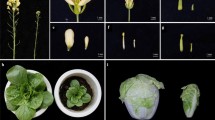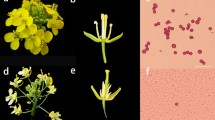Abstract
Sex form is one of the most important characteristics in papaya cultivation in which hermaphrodite is the preferable form. Self-pollination of H*-TSS No.7, an inbred line derived from a rare X chromosome mutant SR*, produced all-hermaphrodite progeny. The recessive lethal allele controlling the all-hermaphrodite phenomenon was proposed to be the recessive Germination suppressor (gs) locus. This study employed next-generation sequencing technology and genome comparison to identify the candidate Gs gene. One specific gene, monodehydroascorbate reductase 4 (MDAR4) harboring a unique polymorphic 3 bp deletion in H*-TSS No.7 was identified. The function of MDAR4 is known to be involved in the hydrogen peroxide (H2O2) scavenging pathway and is associated with seed germination. Furthermore, MDAR4 showed higher expression in the imbibed seeds than that in the dry seeds indicating its potential role in the seed germination. Perhaps this is the very first report providing the evidences that MDAR4 is the candidate of Gs locus in H*-TSS No.7. In addition, Gs allele-specific markers were developed which would be facilitated for breeding all-hermaphrodite lines.



Similar content being viewed by others
Data availability
The raw NGS read of TSS No. 7 genomic sequences are available in DDBJ Sequence Read Archive accession no. DRA009805. The patent of the newly developed gs-allele specific marker is under submission; however, the primers sequence data is available here for the scientific community.
References
Cakmak I, Strbac D, Marschner H (1993) Activities of hydrogen peroxide-scavenging enzymes in germinating wheat seeds. J Exp Bot 44:127–132. https://doi.org/10.1093/jxb/44.1.127
Chan-Tai C, Yen CR, Chang LS, Hsiao CH, Ko TS (2003) All hermaphrodite progeny are derived by self-pollinating the sunrise papaya mutant. Plant Breed 122:431–434. https://doi.org/10.1046/j.1439-0523.2003.00812.x
Chen JR, Urasaki N, Matsumura H, Chen IC, Lee MJ, Chang HJ, Chung WC, Ku HM (2019) Dissecting the all-hermaphrodite phenomenon of a rare X chromosome mutant in papaya (Carica papaya L.). Mol Breed 39:14. https://doi.org/10.1007/s11032-018-0918-7
De Tullio MC, Arrigoni O (2003) The ascorbic acid system in seeds: to protect and to serve. Seed Sci Res 13:249–260. https://doi.org/10.1079/SSR2003143
Doyle JJ, Doyle JL (1987) A rapid DNA isolation procedure for small quantities of fresh leaf tissue. Phyt Bull 19:11–15
Eastmond PJ (2007) Monodehyroascorbate reductase 4 is required for seed storage oil hydrolysis and postgerminative growth in Arabidopsis. Plant Cell 19:1376–1387. https://doi.org/10.1105/tpc.106.043992
Fabi JP, Luana Mendes RBC, Lajolo FM, Oliveira do Nascimento JR (2010) Transcript profiling of papaya fruit reveals differentially expressed genes associated with fruit ripening. Plant Sci 179:225–233. https://doi.org/10.1016/j.plantsci.2010.05.007
FAOSTAT (2018) http://www.fao.org/faostat/en/#data
Kanai M, Hayashi M, Kondo M, Nishimura M (2013) The plastidic DEAD-box RNA helicase 22, HS3, is essential for plastid functions both in seed development and in seedling growth. Plant Cell Physiol 54:1431–1440. https://doi.org/10.1093/pcp/pct091
Lee CY, Lin HJ, Viswanath KK, Lin CP, Chang BCH, Chiu PH, Chiu CT, Wang RH, Chin SW, Chen FC (2018) The development of functional mapping by three sex-related loci the third whorl of different sex types of Carica papaya L. PLoS ONE 13:e0194605. https://doi.org/10.1371/journal.pone.0194605
Leterrier M, Cagnac O (2018) Function of the various MDAR isoforms in higher plants. In: Gupta D, Palma J, Corpas F (eds) Antioxidants and antioxidant enzymes in higher plants. Springer, Cham, pp 83–94
Liao Z, Zhang X, Xhang S, Lin Z, Zhang X, Ming R (2012) Structural variations in papaya genomes. BMC Genomics 22:335. https://doi.org/10.1186/s12864-021-07665-4
Lisenbee CS, Lingard MJ, Trelease RN (2005) Arabidopsis peroxisomes possess functionally redundant membrane and matrix isoforms of monodehydroascorbate reductase. Plant J 43:900–914. https://doi.org/10.1111/j.1365-313X.2005.02503.x
Liu Z, Moore PH, Ma H, Ackerman CM, Raglba M, Yu Q, Pearl HM, Kim MS, Charlton JW, Stiles JI, Zee FT, Paterson AH, Ming R (2004) A primitive Y chromosome in papaya marks incipient sex chromosome evolution. Nature 427:348–352. https://doi.org/10.1038/nature02228
Ming R, Yu Q, Moore PH (2007) Sex determination in papaya. Semin Cell Dev Biol 18:401–408. https://doi.org/10.1016/j.semcdb.2006.11.013
Ming R, Hou S, Feng YuQ et al (2008) The draft genome of the transgenic tropical fruit tree papaya (Carica papaya Linnaeus). Nature 452:991–996. https://doi.org/10.1038/nature06856
Mittler R, Vanderauwera S, Gollery M, Breusegem FV (2004) Reactive oxygen gene network of plants. Trends Plant Sci 9:490–498. https://doi.org/10.1016/j.tplants.2004.08.009
Na J, Wang J, Murray JE, Gschwend AR, Zhang W, Yu Q, Navajas- Pérez R, Feltus FA, Chen C, Kubat Z, Moore PH, Jiang J, Paterson AH, Ming R (2012) Construction of physical maps for the sex-specific regions of papaya sex chromosomes. BMC Genomics 13:176. https://doi.org/10.1186/1471-2164-13-176
Park AK, Kim I, Do H, Jeon BW, Lee CW, Roh SJ, Shin SC, Park H, Kim Y, Kim Y, Yoon H, Lee JH, Kim H (2016) Structure and catalytic mechanism of monodehydroascorbate reductase, MDHAR, from Oryza sativa L. japonica. Sci Rep 6:33903. https://doi.org/10.1038/srep33903
Porter BW, Aizawa KS, Zhu YJ, Christopher DA (2008) Differentially expressed and new non-protein-coding genes from a Carica papaya root transcriptome survey. Plant Sci 174:38–50. https://doi.org/10.1016/j.plantsci.2007.09.013
Stanke M, Keller O, Gunduz I, Hayes A, Waack S, Morgenstern B (2006) AUGUSTUS: ab initio prediction of alternative transcripts. Nucleic Acids Res 34:W435–W439. https://doi.org/10.1093/nar/gkl200
Storey WB (1941) The botany and sex relations of the papaya. Hawaii Agr Exp Stat Bull 87:5–22
Storey WB (1953) Genetics of the papaya. J Heredity 44:70–78. https://doi.org/10.1093/oxfordjournals.jhered.a106358
Tarora K, Irei A, Tamaki M, Kawano S, Yasuda K, Shoda M, Urasaki N, Matsumura H (2018) Production of backcross plants between intergeneric hybrids (Carica papaya × Vasconcellea cundinamarcensis) and C. papaya, as a novel breeding material for Papaya leaf distortion mosaic virus resistance. Breed Res 20:115–123. https://doi.org/10.1270/jsbbr.18J08
Ueno H, Urasaki N, Natsume S, Yoshida K, Tarora K, Shudo A, Terauchi R, Matsumura H (2015) Genome sequence comparison reveals a candidate gene involved in male–hermaphrodite differentiation in papaya (Carica papaya) trees. Mol Genet Genomics 290:661. https://doi.org/10.1007/s00438-014-0955-9
Urasaki N, Tokumoto M, Tarora K, Ban Y, Kayano T, Tanaka H, Oku H, Chinen I, Terauchi R (2002) A male and hermaphrodite specific RAPD marker for papaya (Carica papaya L.). Theor Appl Genet 104:281–285. https://doi.org/10.1007/s001220100693
Urasaki N, Tarora K, Shudo A, Ueno H, Tamaki M, Miyagi N, Adaniya S, Matsumura H (2012) Digital transcriptome analysis of putative sex-determination genes in papaya (Carica papaya). PLoS ONE 7:e40904. https://doi.org/10.1371/journal.pone.0040904
Ushimaru T, Maki Y, Sano S, Koshiba K, Asada K, Tsuji H (1997) Induction of enzymes involved in the ascorbate-depend antioxidative system, namely, ascorbate peroxidase, monodehydroascorbate reductase and dehydroascorbate reductase, after exposure to air of rice (Oryza sativa) seedlings germinated under water. Plant Cell Physiol 38:541–549. https://doi.org/10.1093/oxfordjournals.pcp.a029203
VanBuren R, Zeng F, Chen C, Zhang J, Wai CM, Han J, Aryal R, Gschwend AR, Wang J, Na JK, Huang L, Zhang L, Miao W, Gou J, Arro J, Guyot R, Moore RC, Wang ML, Zee F, Charlesworth D, Moore PH, Yu Q, Ming R (2015) Origin and domestication of papaya Yh chromosome. Genome Res 25:524–533. https://doi.org/10.1101/gr.183905.114
Wang J, Na JK, Yu Q, Gschwend AR, Han J, Zeng F, Aryal R, VanBuren R, Murray JE, Zhang W, Navajas-Pérez R, Feltus AF, Lemke C, Tong EJ, Chen C, Wai CM, Singh R, Wang ML, Min XJ, Alam M, Charlesworth D, Moore PH, Jiang J, Paterson AH, Ming R (2012) Sequencing papaya X and Yh chromosomes reveals molecular basis of incipient sex chromosome evolution. Proc Nat Acad Sci USA 109:13710–13715. https://doi.org/10.1073/pnas.1207833109
Weingartner LA, Moore RC (2012) Contrasting patterns of X/Y polymorphism distinguish Carica papaya from other sex chromosomes systems. Mol Biol Evol 29:3909–3920. https://doi.org/10.1093/molbev/mss196
Wu M, Moore RC (2015) The evolutionary tempo of sex chromosome degradation in Carica papaya. J Mol Evol 80:265–277. https://doi.org/10.1007/s00239-015-9680-1
Yu Q, Tong E, Skelton RL, Bowers JE, Jones MR, Murray JE, Hou S, Guan P, Acob RA, Luo M-C, Moore PH, Alam M, Paterson AH, Ming R (2009) A physical map of the papaya genome with integrated genetic map and genome sequence. BMC Genomics 10:371. https://doi.org/10.1186/1471-2164-10-371
Zhou P, Zhang X, Fatima M, Ma X, Fang H, Ming R (2020) DNA methylome and transcriptome landscapes revealed differential characteristics of dioecious flowers in papaya. Hortic Res 7:81. https://doi.org/10.1038/s41438-020-0298-0
Acknowledgements
The authors thank Prof. Anne Frary, a native English speaker, for critically reviewing and editing the manuscript.
Funding
This work was partial supported to C.-C. Liu (100AS-1.1.8-SS-X4) and J.-R. Chen (105AS-9.7.2-SS-X1) by grants from Council of Agriculture. This work was also financially supported (in part) to Hsin-Mei Ku (MOST 109-2313-B-005-022-MY3) by the grant the Ministry of Science and Technology (MOST) in Taiwan.
Author information
Authors and Affiliations
Contributions
J.-R.C. and H.M. conceived of the experimental design, performed the experiments, data analysis and original manuscript writing. H.U., N.U. and K.T. conducted for bioformation analysis. C.-Y.L., F.-C.C., S.-W.C., C.-C.L., and C.-T.C. prepared plant materials and NGS sequencing. J.-Y.L. and C.-Y.L. prepared breeding materials and MAS. H.-M.K. is the project supervisor and responsible for conducting the project, manuscript writing and submission. All authors read and approved the final version of the manuscript.
Corresponding author
Ethics declarations
Conflicts of interest
The authors declare no conflict of interest.
Ethics approval
The submitted work is original and not has been published elsewhere in any form or language.
Informed consent
All the authors have consent for publication.
Additional information
Communicated by Bing Yang.
Publisher's Note
Springer Nature remains neutral with regard to jurisdictional claims in published maps and institutional affiliations.
Supplementary Information
Below is the link to the electronic supplementary material.
438_2021_1822_MOESM1_ESM.jpg
Multiple sequence alignment of 3 bp Indel (GGTAGT/GGT) polymorphism within MDAR4 gene among H*-TSS No. 7 and 48 papaya lines (KR699083-KR699130) located in the X chromosome. Arrows indicate tri-nucleotide Indel polymorphic sites. ‘*’ indicates conserved residue and ‘-’ indicate no consensus (JPG 1499 KB).
Rights and permissions
About this article
Cite this article
Chen, JR., Ueno, H., Matsumura, H. et al. Genomic characterization of a rare Carica papaya X chromosome mutant reveals a candidate monodehydroascorbate reductase 4 gene involved in all-hermaphrodite phenomenon. Mol Genet Genomics 296, 1323–1335 (2021). https://doi.org/10.1007/s00438-021-01822-w
Received:
Accepted:
Published:
Issue Date:
DOI: https://doi.org/10.1007/s00438-021-01822-w




